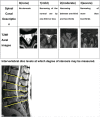Factory and construction work is associated with an increased risk of severe lumbar spinal stenosis on MRI: A case control analysis within the wakayama spine study
- PMID: 30762243
- PMCID: PMC6499731
- DOI: 10.1002/ajim.22957
Factory and construction work is associated with an increased risk of severe lumbar spinal stenosis on MRI: A case control analysis within the wakayama spine study
Abstract
Background: To explore the association of MRI-diagnosed severe lumbar spinal stenosis with occupation.
Methods: Occupational data were collected by questionnaire and all participants underwent spine MRI scans using the same protocol. Central lumbar spinal stenosis (LSS) was graded qualitatively. Those with severe LSS (>two-thirds narrowing) were compared with the controls with lesser degrees of stenosis or no stenosis.
Results: Data were available for 722 subjects, mean age 70.1 years. 239 (33%) cases with severe LSS were identified. Factory/construction workers had an almost four-fold increased risk of severe LSS after adjustment for age, sex, smoking, and walking speed amongst those aged <75 years (OR 3.97, 95%CI 1.46-10.85). Severe LSS was also associated with squatting ≥1 h/day (OR 1.76, 95%CI 1.01-3.07) but this association became non-significant after adjustment.
Conclusion: Further research is needed but this study adds more evidence that occupational factors are associated with an increased risk and/or severity of degenerative disease of the lumbar spine.
Keywords: Lumbar spinal stenosis (LSS); MRI; factory and construction workers; occupation; occupational exposures.
© 2019 The Authors. American Journal of Industrial Medicine Published by Wiley Periodicals, Inc.
Figures
Similar articles
-
Relationship between alterations of the lumbar spine, visualized with magnetic resonance imaging, and occupational variables.Eur Spine J. 2007 Feb;16(2):255-66. doi: 10.1007/s00586-005-0036-1. Epub 2006 Jul 12. Eur Spine J. 2007. PMID: 16835739 Free PMC article.
-
The association between tobacco smoking and surgical intervention for lumbar spinal stenosis: cohort study of 331,941 workers.Spine J. 2018 Aug;18(8):1313-1317. doi: 10.1016/j.spinee.2017.11.018. Epub 2017 Dec 12. Spine J. 2018. PMID: 29246850
-
Prevalence of symptomatic lumbar spinal stenosis and its association with physical performance in a population-based cohort in Japan: the Wakayama Spine Study.Osteoarthritis Cartilage. 2012 Oct;20(10):1103-8. doi: 10.1016/j.joca.2012.06.018. Epub 2012 Jul 10. Osteoarthritis Cartilage. 2012. PMID: 22796511
-
The clinical significance of redundant nerve roots of the cauda equina in lumbar spinal stenosis patients: A systematic literature review and meta-analysis.Clin Neurol Neurosurg. 2018 Nov;174:40-47. doi: 10.1016/j.clineuro.2018.09.001. Epub 2018 Sep 4. Clin Neurol Neurosurg. 2018. PMID: 30205275
-
Lumbar Spinal Stenosis in Older Adults.Rheum Dis Clin North Am. 2018 Aug;44(3):501-512. doi: 10.1016/j.rdc.2018.03.008. Epub 2018 Jun 12. Rheum Dis Clin North Am. 2018. PMID: 30001789 Review.
Cited by
-
Is radiographic lumbar spinal stenosis associated with the quality of life?: The Wakayama Spine Study.PLoS One. 2022 Feb 17;17(2):e0263930. doi: 10.1371/journal.pone.0263930. eCollection 2022. PLoS One. 2022. PMID: 35176078 Free PMC article.
-
Risk Factors for Surgical Treatment of Lumbar Degenerative Disc Disease in Middle-aged and Older Women: A Prospective Case-Control Study of 2370 Subjects.Orthop Surg. 2024 Jun;16(6):1284-1291. doi: 10.1111/os.14066. Epub 2024 Apr 18. Orthop Surg. 2024. PMID: 38637331 Free PMC article.
References
-
- Hadler NM, Gillings DB, Imbus HR, et al. Hand structure and function in an industrial setting. Arthritis Rheum. 1978; 21:210–220. - PubMed
-
- Yoshimura N, Nishioka S, Kinoshita H, et al. Risk factors for knee osteoarthritis in Japanese women: heavy weight, previous joint injuries, and occupational activities. J Rheumatol. 2004; 31:157–162. - PubMed
-
- Jensen LK. Hip osteoarthritis: influence of work with heavy lifting, climbing stairs or ladders, or combining kneeling/squatting with heavy lifting. Occup Environ Med. 2008; 65:6–19. - PubMed
Publication types
MeSH terms
Grants and funding
LinkOut - more resources
Full Text Sources
Medical



